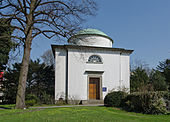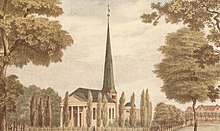Schimmelmann mausoleum
The Schimmelmann mausoleum is the burial place of Heinrich Carl von Schimmelmann and his wife Caroline. It is not far from the Christ Church in Hamburg-Wandsbek . It is considered one of the main works of classicism in northern Germany.
Heinrich Carl von Schimmelmann and his wife Caroline von Schimmelmann
Heinrich Carl von Schimmelmann came from a merchant family in Demmin and rose to the rank of count in Denmark and one of the richest men in Europe. Among other things, he acquired his fortune with the Atlantic triangular trade . Through a Fideikommiss he left his descendants annual income from his Caribbean plantations of at least 64,000 Reichstalers as well as further assets of an estimated several million Talers. His wife Caroline, née von Friedeborn, called von Gersdorff, was born in Dresden in 1730 . The wedding took place on March 4, 1747 in Dresden.
Design and construction
In 1769, long before his death, Schimmelmann first negotiated his grave with the sculptor Johannes Wiedewelt . Carl Heinrich von Schimmelmann died at the age of 58 on February 15, 1782 in Copenhagen and was first buried there in the St. Petri Church of the German community. A firm order for the design of the tomb was initially awarded in 1784 to the Italian artist Luigi Grossi, who lived in Copenhagen. However, since he did not meet his obligations, the contract was terminated after only six months. In 1785, Carl Gottlob Horn finally received the official commission to design the mausoleum. Horn's designs were submitted to the Italian architect Giovanni Antonio Antolini in order to avoid possible violations of the classicist style rules. Antolini in turn sent adapted drafts back to Horn. 13 of these drafts have been preserved in the Hamburg State Archives to this day. Horn relied on these sketches and reworked them. The plans were significantly simplified, including a portico planned by Antolini in Horn's designs, and the spiral staircases originally intended in the corners were also omitted. The first completed draft dates from 1785, but for Schimmelmann's descendants it was still too complex and expensive, so Horn had to simplify it further. For example, instead of sandstone, the building should now be built with fired bricks and the underground vaulted crypt should be dispensed with.
How difficult it was for the descendants to fulfill their wills despite the inheritance of several million Reichstaler is shown in a letter from his son-in-law, Count Baudissin, to his brother-in-law Ernst Schimmelmann: “ I cannot do without anything from the income of the entails and the shares, because I my household have set it and it would not send the same at once again limit. " . The mortal remains of Schimmelmann were transferred to Wandsbek in 1785 and initially buried in a crypt in the interior of the church on October 24th. Construction of the tomb began in 1787 and was completed in 1791. Count Schimmelmann was buried in his mausoleum in 1792, ten years after his death. His wife died in 1795 and was also buried in the tomb.
Interior
While the exterior of the mausoleum appears rather simple, the interior of the domed hall is richly decorated with stucco . The central dome is supported by four Doric columns . On the north and south sides there are two half domes, while a semicircular window was installed on the east and west sides to illuminate the interior. The two sarcophagi are in the semicircular side niches on the north and south sides of the tomb. These were made in Italy from dark, yellow-veined Carrara marble . They are composed of thinly polished plates and shells and arrived in the port of Hamburg by ship in October 1790. This freight also contained the marble slabs for the floor. This is composed like a mosaic and consists of different colored pieces that are shaped in the middle to a rosette , around which rectangular white marble bands form a geometric pattern. The colored stucco work was probably created by Francesco Antonio Tadey based on designs by Carl Gottlob Horn . The Fortuna on Schimmelmann's sarcophagus and the Pietas , as an allegory of piety, above the sarcophagus of Schimmelmann's wife Caroline are to be emphasized .
Another story
For the future maintenance of the mausoleum, the bereaved donated 3,600 Reichstaler. Renovations were then required in quick succession. Corresponding work is documented for the years 1824, 1829, 1851, 1876, 1879 and 1882. In 1842 Schimmelmann's son Count Christian Friedrich was buried in the mausoleum. In 1896 the entrance was moved from the west to the east.
During the First World War , the copper roof was melted down for armaments purposes and replaced by a temporary roof. At the suggestion of Wandsbeker pastor Boie, the mausoleum became a memorial to the Wandsbeks who died in the war in 1923. The sarcophagi were sunk in a flat vault around a meter below the floor and twenty plaques with a total of 1000 names were attached to the walls of the mausoleum. The inauguration took place on the occasion of the 300th anniversary of the parish. In 1930/31 the temporary roof had become so leaky that the ceiling and walls were damaged and the building had to be closed because of the danger. The Schimmelman's legacy intended for preservation had been destroyed by the inflation, which is why the publisher of the Wandsbeker Boten, Wilhelm Puvogel, asked for donations. With this money, the damage could be repaired and another plaque with subsequently reported war victims and another plaque about the creation of the memorial could be attached. On June 17, 1940, the building was entered in the Hamburg monument list and was given the number 190 there.
Almost all the surrounding buildings fell victim to the bombs of the Second World War . The mausoleum survived this time, but was again damaged by vibrations and the heat of the fire. An emergency renovation followed in 1947 and major repairs in 1951. Between 1958 and 1965 the building was heated and the roof was given a new copper cladding. The nameplates of those who fell in World War I were removed and relocated to the Christ Church . During the laying of the central heating pipes in 1959, a burial was found near the east wall , which was assumed to contain the remains of Christian Friedrich Schimmelmann, who died in 1842. A little south of the center of the chapel, but still below the marble rosette, another burial was found, probably that of Heinrich Carl von Schimmelmann. No further investigations were carried out. It is considered certain that the sarcophagi are pure show coffins and therefore empty. A quote from Matthias Claudius was placed on the wall opposite the entrance .
Benefits -
deaths are given quietly and purely - those who live in the grave
are flowers - those that stand in the storm
are little stars - that do not perish
On the east wall above the sarcophagus it says:
Carolina Tugendreich Countess von Schimmelmann
née von Friedeborn gen von Gersdorff
Geb. d. Sept. 29, 1730 in Görlitz
Gest. d. November 30, 1795 in Hamburg
On the west wall above the sarcophagus it says:
Heinrich Carl Graf von Schimmelmann
Royal Danish Conferential Councilor and Treasurer
Knight of the Elephant Order
Geb. d. July 12, 1724 to Demmin
Gest. d. February 15, 1782 in Copenhagen
The most recent extensive renovations took place between 1988 and 1990.
Web links
Individual evidence
- ↑ a b Michael Pommerening: Wandsbek A historical tour . Mühlenbek-Verlag, Hamburg 2010, ISBN 3-9807460-6-2 , p. 152 . P. 92 f.
- ^ Helmuth Fricke, Michael Pommerening, Richard Hölck: The churches on the Wandsbeker market . Mühlenbek-Verlag, Hamburg 2002, ISBN 3-9807460-2-X , p. 120 . P. 39.
- ↑ Martin Knorr: The castle builder Carl Gottlob Horn and the burial chapel of Count Heinrich Carl von Schimmelmann - special edition of the Adler-Apotheke-Wandsbek . Hamburg 1971, p. 8 . P. 7.
Coordinates: 53 ° 34 ′ 23.49 " N , 10 ° 4 ′ 19.31" E











